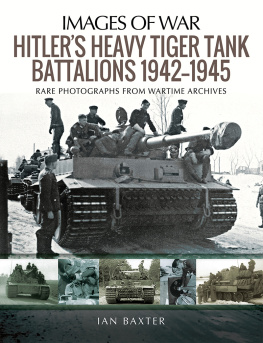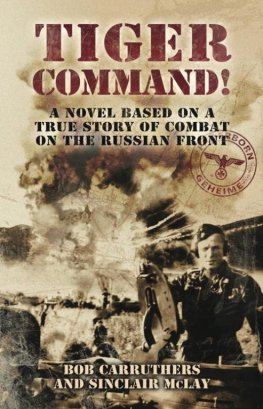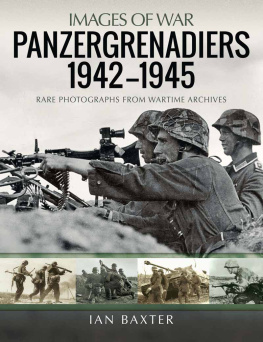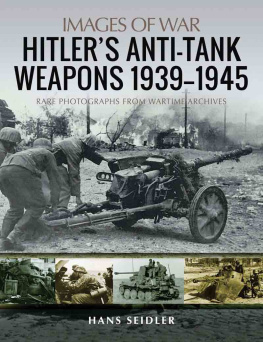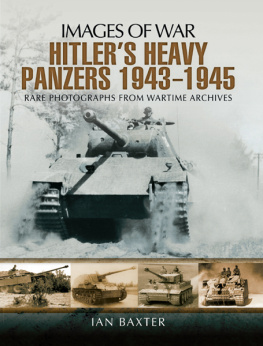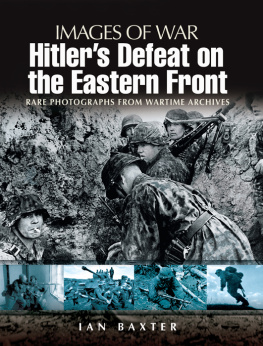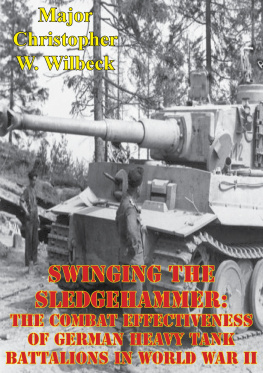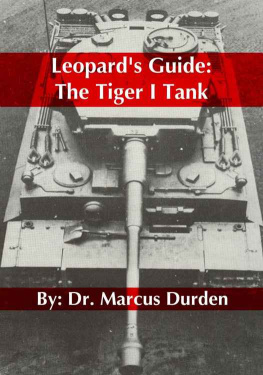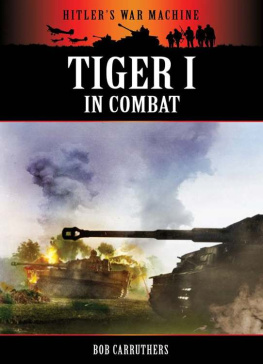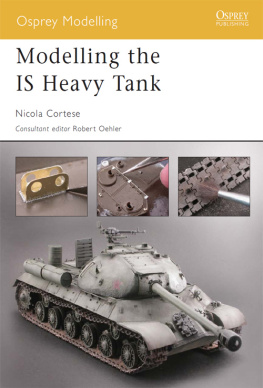Baxter Ian - Hitlers Heavy Tiger Tank Battalions 1942-1945
Here you can read online Baxter Ian - Hitlers Heavy Tiger Tank Battalions 1942-1945 full text of the book (entire story) in english for free. Download pdf and epub, get meaning, cover and reviews about this ebook. year: 2020, publisher: Pen & Sword Books Limited, genre: Non-fiction. Description of the work, (preface) as well as reviews are available. Best literature library LitArk.com created for fans of good reading and offers a wide selection of genres:
Romance novel
Science fiction
Adventure
Detective
Science
History
Home and family
Prose
Art
Politics
Computer
Non-fiction
Religion
Business
Children
Humor
Choose a favorite category and find really read worthwhile books. Enjoy immersion in the world of imagination, feel the emotions of the characters or learn something new for yourself, make an fascinating discovery.
- Book:Hitlers Heavy Tiger Tank Battalions 1942-1945
- Author:
- Publisher:Pen & Sword Books Limited
- Genre:
- Year:2020
- Rating:3 / 5
- Favourites:Add to favourites
- Your mark:
- 60
- 1
- 2
- 3
- 4
- 5
Hitlers Heavy Tiger Tank Battalions 1942-1945: summary, description and annotation
We offer to read an annotation, description, summary or preface (depends on what the author of the book "Hitlers Heavy Tiger Tank Battalions 1942-1945" wrote himself). If you haven't found the necessary information about the book — write in the comments, we will try to find it.
Baxter Ian: author's other books
Who wrote Hitlers Heavy Tiger Tank Battalions 1942-1945? Find out the surname, the name of the author of the book and a list of all author's works by series.
Hitlers Heavy Tiger Tank Battalions 1942-1945 — read online for free the complete book (whole text) full work
Below is the text of the book, divided by pages. System saving the place of the last page read, allows you to conveniently read the book "Hitlers Heavy Tiger Tank Battalions 1942-1945" online for free, without having to search again every time where you left off. Put a bookmark, and you can go to the page where you finished reading at any time.
Font size:
Interval:
Bookmark:

IMAGES OF WAR
RARE PHOTOGRAPHS FROM WARTIME ARCHIVES
Ian Baxter

First published in Great Britain in 2020 by
PEN & SWORD MILITARY
An imprint of
Pen & Sword Books Ltd
47 Church Street
Barnsley
South Yorkshire
S70 2AS
Copyright Ian Baxter, 2020
ISBN 978-1-52674-787-7
eISBN 978-1-52674-788-4
Mobi ISBN 978-1-52674-789-1
The right of Ian Baxter to be identified as author of this work has been asserted by him in accordance with the Copyright, Designs and Patents Act 1988.
A CIP catalogue record for this book is available from the British Library.
All rights reserved. No part of this book may be reproduced or transmitted in any form or by any means, electronic or mechanical including photocopying, recording or by any information storage and retrieval system, without permission from the Publisher in writing.
Pen & Sword Books Limited incorporates the imprints of Atlas, Archaeology, Aviation, Discovery, Family History, Fiction, History, Maritime, Military, Military Classics, Politics, Select, Transport, True Crime, Air World, Frontline Publishing, Leo Cooper, Remember When, Seaforth Publishing, The Praetorian Press, Wharncliffe Local History, Wharncliffe Transport, Wharncliffe True Crime and White Owl.
For a complete list of Pen & Sword titles please contact
PEN & SWORD BOOKS LIMITED
47 Church Street, Barnsley, South Yorkshire S70 2AS, England
E-mail:
Website: www.pen-and-sword.co.uk
I an Baxter is a military historian who specialises in German twentieth-century military history. He has written more than fifty books including Poland The Eighteen Day Victory March , Panzers In North Africa , The Ardennes Offensive , The Western Campaign , The 12th SS Panzer-Division Hitlerjugend , The Waffen-SS on the Western Front , The Waffen-SS on the Eastern Front , The Red Army at Stalingrad , Elite German Forces of World War II , Armoured Warfare , German Tanks of War , Blitzkrieg , Panzer-Divisions at War , Hitlers Panzers , German Armoured Vehicles of World War Two , Last Two Years of the Waffen-SS at War , German Soldier Uniforms and Insignia , German Guns of the Third Reich , Defeat to Retreat: The Last Years of the German Army At War 194345 , Operation Bagration the Destruction of Army Group Centre , German Guns of the Third Reich , Rommel and the Afrika Korps , U-Boat War , and most recently The Sixth Army and the Road to Stalingrad . He has written over a hundred articles including Last days of Hitler, Wolfs Lair, The Story of the V1 and V2 Rocket Programme, Secret Aircraft of World War Two, Rommel at Tobruk, Hitlers War With his Generals, Secret British Plans to Assassinate Hitler, The SS at Arnhem, Hitlerjugend, Battle of Caen 1944, Gebirgsjger at War, Panzer Crews, Hitlerjugend Guerrillas, Last Battles in the East, The Battle of Berlin, and many more. He has also reviewed numerous military studies for publication, supplied thousands of photographs and important documents to various publishers and film production companies worldwide, and lectures to various schools, colleges and universities throughout the United Kingdom and the Republic of Ireland.
U sing rare and unpublished photographs, Hitlers Heavy Tiger Tank Battalions is an illustrated record of German heavy tank battalions or Schwere Panzer Abteilungen during operations on the Eastern, Western and Italian fronts between 1942 and 1945. It represents a visual account of the various elite battalion- sized tank units of the Wehrmacht and Waffen-SS equipped with the Tiger I and later Tiger II heavy tanks.
The book shows early formation units comprising twenty Tigers and sixteen medium Pz.Kpfw.IIIs, it illustrates the various vehicles that each battalion used in a supporting role, and the special independent Tiger tank maintenance companies which kept the vehicles in fighting condition. Much was owed by the Tiger tank battalions to their maintenance teams, which were able to quickly repair combat damage and return tanks to the battlefield to inflict more harm on the enemy.
The development of the Tiger tank battalions is traced from their deployment on the Eastern Front in 1942, Italy a year later, France in 1944, and to defensive actions outside Berlin in 1945. With detailed captions and text the book tells the story of how these battalions evolved and shows that although they were successful on the battlefield, mechanical unreliability continuously reduced the battalions to smaller and smaller combat-ready units. These heavy tanks, which were constantly required to fight offensive and defensive missions, were shuffled around and organised into ad hoc units according to conditions on the battlefield. Huge numbers were lost, but in spite of this the battalions fought on until the last days of the war, when the crews finally destroyed their equipment and surrendered to their enemies.
F or the invasion of Russia, codenamed Barbarossa, the German army assembled some 3 million men, divided into 105 infantry divisions and 32 Panzer divisions. There were 3,332 tanks, over 7,000 artillery pieces, 60,000 motor vehicles and 625,000 horses. The Panzer divisions heavy armour at that time comprised some 439 Pz.Kpfw.IVs, but for light armour it had to rely on obsolete light tanks.
For the Russian offensive the Panzer divisions had been slightly modified in armoured firepower and diluted in strength in order to form more divisions. The planners thought that by concentrating a number of Panzer divisions together they would be able to achieve massive local superiority.
These new Panzer divisions contained one tank regiment of two, sometimes three, Abteilungen, totalling some 150200 tanks; two motorized rifle (schtzen) regiments, each of two battalions, whose infantry were carried in armoured halftracks or similar vehicles, and a reconnaissance battalion of three companies (one motorcycle, two armoured cars). The motorized infantry divisions accompanying the Panzer divisions in the Panzergruppe were similarly organized, but badly lacked armoured support. The divisional artillery comprised of two field, one medium and one antitank regiment and an anti-aircraft battalion. These were all motorised and more than capable of keeping up with the fast-moving Panzers.
When the German invasion of Russian was finally unleashed on the morning of 22 June 1941 the Panzer divisions progressed exceptionally well and continued over the next several weeks penetrating deeply into Russia. By late July the German armies were fighting on a front more than 1,000 miles wide. The Panzer divisions had exploited the terrain and struck such a series of blows to the Red Army that commanders predicted that it was only a matter of time before the campaign would be over.
Inevitably the Panzer divisions were thinly spread out, and they were moving so fast that supporting units were barely able to keep pace with them. Nevertheless, between June and late September 1941, the panzer and motorized divisions were more or less unhindered by lack of supply. Neither did the terrain or weather conditions cause them problems. However, on 6 October the first snowfall of the approaching winter was reported. It melted quickly but turned the dirt roads to mud. Autumn had arrived. The Panzer divisions began to slow. Wheeled vehicles became stuck and had to be towed. The attack had been launched later than intended and preparations for bad weather were inadequate. There were no chains available for towing vehicles, no anti-freeze for engine coolant systems, and soldiers had no winter clothing.
Font size:
Interval:
Bookmark:
Similar books «Hitlers Heavy Tiger Tank Battalions 1942-1945»
Look at similar books to Hitlers Heavy Tiger Tank Battalions 1942-1945. We have selected literature similar in name and meaning in the hope of providing readers with more options to find new, interesting, not yet read works.
Discussion, reviews of the book Hitlers Heavy Tiger Tank Battalions 1942-1945 and just readers' own opinions. Leave your comments, write what you think about the work, its meaning or the main characters. Specify what exactly you liked and what you didn't like, and why you think so.

